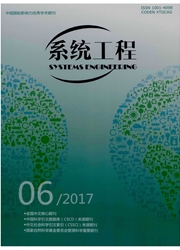

 中文摘要:
中文摘要:
以制造商和零售商组成的二级绿色供应链为背景,运用博弈论方法,考虑风险规避度和产品绿色度、消费者偏好等因素,建立了集中决策博弈模型和制造商领导Stackelberg博弈模型。比较了两种博弈模型中,产品绿色度、批发价格、产品价格与风险规避度的相互影响,以及风险规避度对制造商效用和零售商效用的影响,最后进行了数值仿真。研究表明:在集中决策模型中,存在产品绿色度的临界值;当制造商和零售商的风险规避度不变时,制造商、零售商的期望收益随着产品绿色度的提高而降低。在制造商领导Stackelberg博弈模型中,批发价格随着制造商风险规避度的增加而增加;产品的绿色度越高,制造商的批发价格和零售商的产品价格均提高。
 英文摘要:
英文摘要:
Against the background of two-stage-green supply chain consisting of a manufacturer and a retailer,considering the degree of risk aversion and product greenness,consumer preferences and other factors,this paper proposes the centralized decision-making game models and manufacturers led Stackelberg game model and then compares the interaction of product greenness,wholesale prices,product prices and risk aversion and risk aversion utility for manufacturers and retailers in these two game models.Finally the numerical simulation is conducted.Results show that:(1)In the centralized decision-making model,there is a critical value of the product greenness;when risk aversion of manufacturers and retailers is constant,the total expected revenue of manufacturers and retailers will increase as the product greenness improved.(2)In the Stackelberg game model Led by the manufacturer,the wholesale price increase as manufacturers risk aversion improved;The higher the product greenness,the manufacturer's wholesale price and retail price retailers are improved.When the manufacturer is risk-aversive and retailer is risk neutral,the profit of retailer in Stackelberg game model Led by the manufacturer is larger than that in the centralized decision-making mode.
 同期刊论文项目
同期刊论文项目
 同项目期刊论文
同项目期刊论文
 期刊信息
期刊信息
